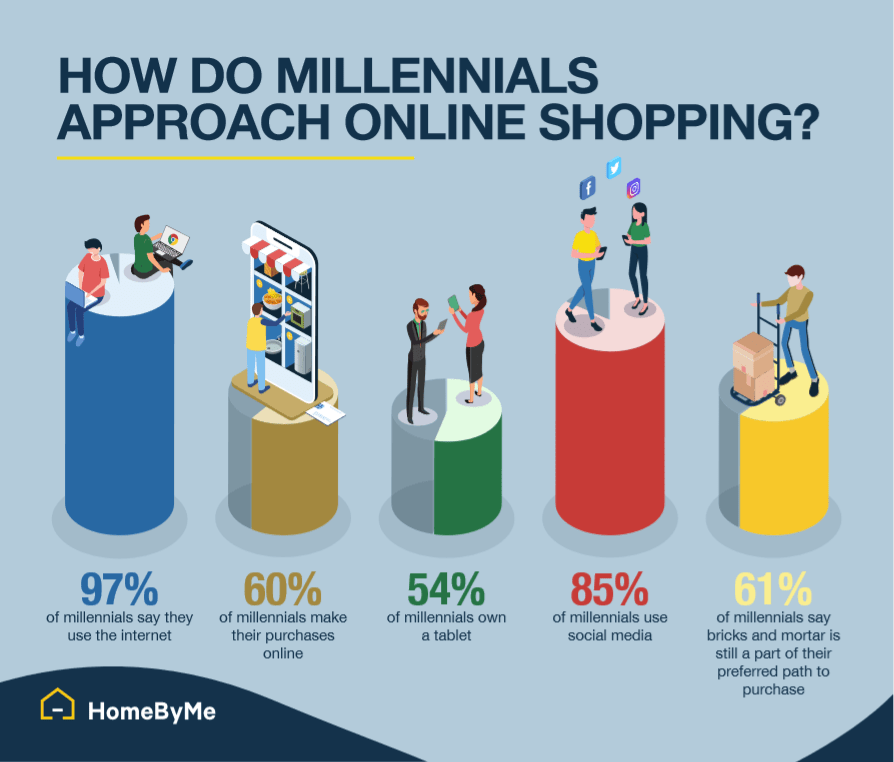Sales and Operations October 18, 2019
How 3D planning can enable home retailers to tap into the millennial market

Global online furniture sales are set to increase at an average annual growth rate of 11.9% between 2018 and 2022
according to research, resulting in a market volume of $294 billion in 2022. 50% of the customers contributing to this growth are millennials and Gen Z. The buying journey for these two generations encompasses heavy online research and social shopping alongside in-store exploration. So, how do businesses appeal to this new generation of buyers in order to offer the omnichannel experience they require, and grab the biggest market share for their home retail business?
A great solution to this challenge can be found in 3D planning solutions. Advances in technology such 3D planning and augmented reality provide brands with the ability to connect to this thriving younger generation by bridging the gap between online and social channels, and in-person experiences.
An online first approach to buying

Research indicates that in 2019 millennials (consumers born from 1982-1996) will make 60% of their purchases online and that 54% own a tablet. The information they see on social media has a huge influence on their buying decisions and they now make more online purchases on devices such as tablets or smartphones than on desktop computers. Millennials place great importance on online reviews and their shopping habits align well with a more interactive way of connecting.
As part of this desire to interact they may send a picture of a sofa they like to their friends on Facebook to see what they think, or visit a retailer’s bricks and mortar store to get a feel for fabrics and textures. Brands that integrate the real-world experience with the online one for a true omnichannel buying journey will align best with this demographic.
Social shopping has transformed e-commerce
Millennials have been closely linked to the new emerging trend of social shopping, with their purchasing habits highly influenced by social media. This generation is the first to have grown up immersed in technology and frequently spends a generous amount of time on social networks, from blogs and forums, to picture and video sharing platforms. They log on not only to connect and share with their friends and family but also to research and gather product information, reviews and make purchases. Not surprisingly, this group is driving the rise of social commerce.
According to research by Salmon, almost a quarter (24%) of consumers in both the US and UK are using social networks to recommend products to friends. As a channel that consumers are actively using, there is a growing need for retailers to embrace social shopping and use these platforms to reach their audience, especially when it comes to millennial shoppers. Social media is a huge part of their lives and it has relevance all the way along the furniture buyer journey, from informing decision-making about which product to buy, to enabling omnichannel paths to purchasing.
Over the coming years, social platforms will increasingly facilitate the actual purchasing process. Social commerce, the process of selling products directly through social networks, is already happening. Social media platforms have looked beyond simply selling leads and traffic, and are now aiming to bridge the e-commerce gap by providing the ability to complete purchases without leaving their platform. An example of this would be Instagram’s shoppable posts and Facebook’s Marketplace, with the trend likely to continue. This will truly change the sales funnel and buyer journey, transforming the way that retailers sell their goods.
3D planning can help brands connect to the younger generation
Millennials are very visually oriented. They consume photo and video information regularly online, but they still crave real world engagement which they achieve by venturing out to bricks and mortar stores to browse in person and do some of their purchasing. However, it is difficult to bring the emotional and tangible aspect of physical retail into the digital world, especially with home furnishings, and that is where 3D product imaging comes in.
3D product imaging is a technology that brings an in-store experience to online shopping through high-resolution images. This makes it possible for retailers to provide their online customers with a graphical and interactive 3D product. Customers can choose the item they’d like to see, zoom in and out, rotate the object, change its color or pattern, place it in their home-designed space, and more. The customer can visualize, conceptualize, and design their space in the comfort of their home, experimenting with different furniture options. They can then visit the in-store armed with their ideas. As the online shopping experience continues to evolve, home retailers will need to utilize the technology available to appeal to the emotions of this and the next generation of customers.
What can be expected for Generation Z?
Generation Z relates to consumers born between 1997 and 2012, and understanding these buyers will be crucial for all retail businesses who are interested in growing with the next generation. Smartphones, tablets, laptops, desktops, and TVs all provide an interconnected experience. Generation Z favor Instagram and YouTube as their preferred social mediums and have all but abandoned Facebook.
85% of Generation Z use social media to learn about new products, so a strong social media presence will be necessary for retailers looking to target these consumers. In addition, 69% of Generation Z consumers will visit a store based on a retailer’s social media posts and nearly 80% have been influenced to shop at a retailer they have never been to before through social media.
As far as shopping trends go it might come as a surprise but the majority of Generation Z shop in physical stores more often than online. This could be partly due to the lack of access to credit cards for the younger members of this generation, however it will be important for retailers to keep an eye on the statistics for this group as they emerge.
Building a connection is key
Connecting with millennials online is critical to garnering their business and providing a truly seamless omnichannel experience will help to differentiate and propel businesses. When buying retail furniture, millennial shoppers want to know exactly what they are going to get in return for their investment. By utilizing 3D planning solutions, retailers can bridge the gap between online and offline shopping, helping shoppers more effectively visualize products before purchasing.
For furniture retail companies of all sizes, social shopping and omnichannel experiences, combined with superior product visualization, will allow them to tap into the millennial market and grasp the growth opportunities available.
To further explore on how you can tap into the millennial market through an effective omni-channel approach using 3D planning, visit our website built specifically to serve home retailers where you can organize a demonstration of the platform with a member of our team of experts.


